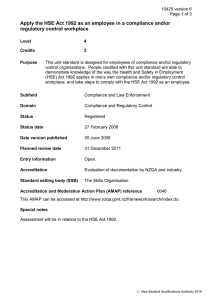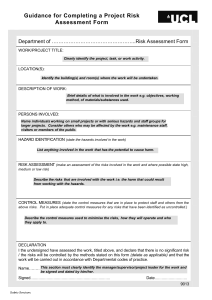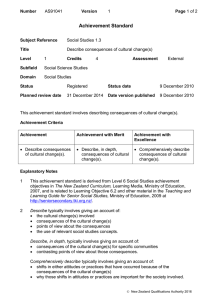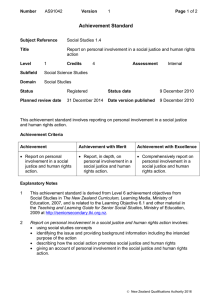CONSTRUCTION HEALTH AND SAFETY, AND INJURY PREVENTION Prevent hazards associated with
advertisement
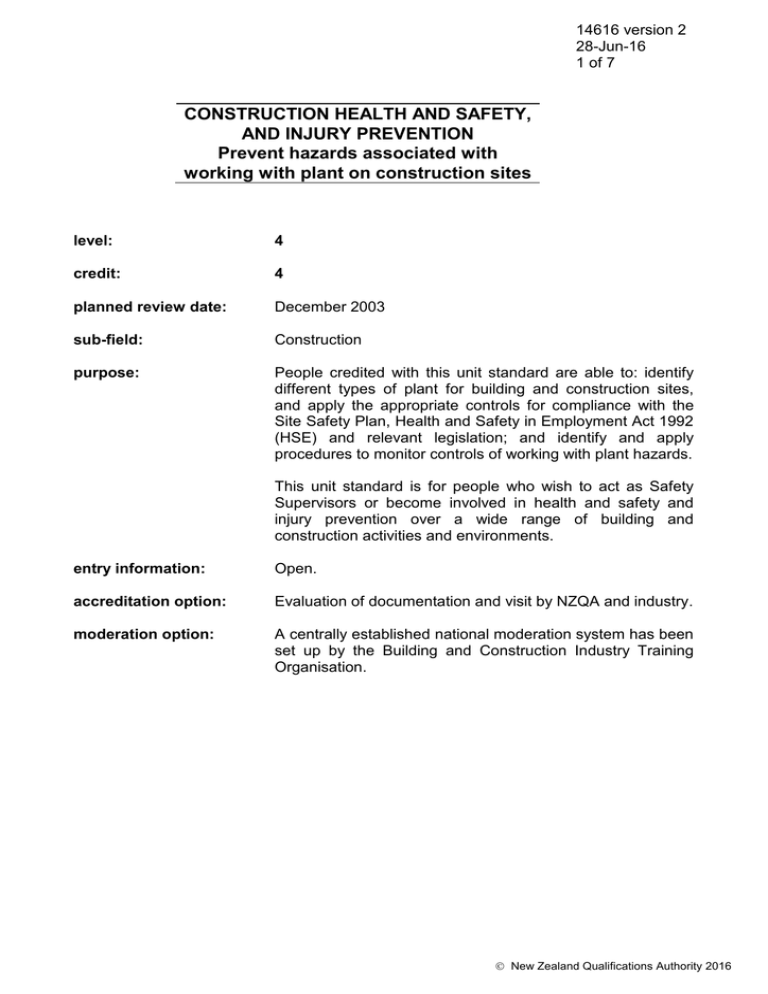
14616 version 2 28-Jun-16 1 of 7 CONSTRUCTION HEALTH AND SAFETY, AND INJURY PREVENTION Prevent hazards associated with working with plant on construction sites level: 4 credit: 4 planned review date: December 2003 sub-field: Construction purpose: People credited with this unit standard are able to: identify different types of plant for building and construction sites, and apply the appropriate controls for compliance with the Site Safety Plan, Health and Safety in Employment Act 1992 (HSE) and relevant legislation; and identify and apply procedures to monitor controls of working with plant hazards. This unit standard is for people who wish to act as Safety Supervisors or become involved in health and safety and injury prevention over a wide range of building and construction activities and environments. entry information: Open. accreditation option: Evaluation of documentation and visit by NZQA and industry. moderation option: A centrally established national moderation system has been set up by the Building and Construction Industry Training Organisation. New Zealand Qualifications Authority 2016 14616 version 2 28-Jun-16 2 of 7 CONSTRUCTION HEALTH AND SAFETY, AND INJURY PREVENTION Prevent hazards associated with working with plant on construction sites special notes: 1 Compliance is required with the hierarchy of controls outlined in the Health and Safety in Employment Act 1992 (HSE), i.e: elimination of significant hazards; isolation of significant hazards when elimination is not practicable; and minimisation of significant hazards where elimination and isolation are not practicable. 2 All practical steps means all steps to achieve the result that it is reasonably practicable to take in the circumstances, having due regard to: nature and severity of the harm; current state of knowledge about that harm; current state of knowledge about the means available to achieve the result and availability and cost of each of those means. 3 Hazards refer to those occurrences, processes, substances or situations as determined by the supervisor that are an actual or potential cause or source of harm associated with, but not limited to: process, activities, environment, equipment, materials, work organisation, site and facilities. Contributing factors may include noise, vibration, temperature, pressure and mechanical, ergonomic stressors, and chemical agents. 4 Codes of Practice refer to any issued code of practice approved by the Minister of Labour under Section 20 of the Health and Safety in Employment Act 1992 (HSE), and any work carried out in accordance with that code. Specific Publication – Approved Code of Practice for Powder-actuated Hand-held Fastening tools, issued by the Occupational Safety and Health Service of the Department of Labour, May 1995. New Zealand Qualifications Authority 2016 14616 version 2 28-Jun-16 3 of 7 CONSTRUCTION HEALTH AND SAFETY, AND INJURY PREVENTION Prevent hazards associated with working with plant on construction sites 5 Standards refer to any New Zealand or other Standards that provide technical guidance and specifications. Standards may also be specified in Regulations. 6 Guidelines refer to any information on health and safety produced by the Occupation Safety and Health Service of the Department of Labour or Accident Compensation Corporation for the provision of health, safety and injury prevention in the building and construction industry. The guidelines are referenced to Regulations, situations or hazards, and may be based on relevant sections of the Health and Safety in Employment Act 1992, Health and Safety in Employment Regulations 1995, Standards contained in former legislation, or accepted good practice and supportive information. Specific publication - Provision of Facilities and General Safety in the Construction Industry, issued by the Occupational Safety and Health Service of the Department of Labour, April 1996. 7 Legislation relevant to this unit standard includes, but is not limited to: the Health and Safety in Employment Act 1992 (HSE) and Health and Safety in Employment Regulations 1995, specifically, the definitions referring to Construction Work and Notifiable Work; Human Rights Act 1993; Privacy Act 1993; Local Government Act 1974; Resource Management Act 1991; Building Act 1991. 8 Safety Supervisor is defined as a person recognised as a health and safety practitioner pertaining to the building and construction industry or trades. New Zealand Qualifications Authority 2016 14616 version 2 28-Jun-16 4 of 7 CONSTRUCTION HEALTH AND SAFETY, AND INJURY PREVENTION Prevent hazards associated with working with plant on construction sites 9 Organisation may refer to any business engaging, controlling, or employing people in a building and construction environment. 10 Site Safety Plan is defined as a building and construction site specific document that demonstrates an organisation’s means of compliance with the Health and Safety in Employment Act 1992, and includes but is not limited to the following: assignment of responsibilities for on site implementation; hazard identification methods; accident investigation and report methods; site emergency procedures; site communication strategy; strategy for the co-ordination of on site trade activities; site audit procedures. 11 This unit standard requires assessment in a practical work situation, on site. On site refers to a wide range of building and construction environments within which trade skills are required. New Zealand Qualifications Authority 2016 14616 version 2 28-Jun-16 5 of 7 CONSTRUCTION HEALTH AND SAFETY, AND INJURY PREVENTION Prevent hazards associated with working with plant on construction sites Elements and Performance Criteria element 1 Identify different types of work involving mechanical plant, power machinery and tools, powered powder-actuated tools and electricity for building and construction sites and apply the appropriate controls for compliance with the Site Safety Plan, Health and Safety in Employment Act 1992 (HSE) and relevant legislation. Range: including but not limited to - mechanical plant, power machinery and tools, powered powder-actuated tools and electrical work on building and construction sites; operating, cleaning, inspection, maintenance or repair of machinery, tools and equipment; and associated electrical work and supply. performance criteria 1.1 Hazards are identified in terms of each type of plant, powered machinery, tools and electrical work to identify the controls required for health and safety compliance. Range: hazard factors include but are not limited to - in terms of machinery and tools, conditions of site and working environment, unsuitable materials, misfiring, uncontrolled use, insufficient or no warning signs, lack of personal protective clothing and equipment, location of other services, disregard to manufacturer’s requirements and operating instructions, uncertified operators (where relevant), lack of training and supervision, limitations of use, lack of identification and inspection dates, fire and explosive atmospheres, insufficient routine checks, safety of persons; in terms of electrical work - weather conditions and damp situations, voltage between conductors, supply not isolated, inadequate earth circuits, substandard temporary supply switchboards, underground and overhead lines. New Zealand Qualifications Authority 2016 14616 version 2 28-Jun-16 6 of 7 CONSTRUCTION HEALTH AND SAFETY, AND INJURY PREVENTION Prevent hazards associated with working with plant on construction sites 1.2 Controls required when carrying out work associated with powered machinery, tools and electricity are applied to ensure that all practical steps are taken to maintain health and safety compliance. Range: areas to be considered but not limited to - Electrical - supply, temporary supply switchboards, inspection of equipment, clearance from power lines, monitored earth circuit and automatic disconnection devices, double insulated appliances, residual current device, supply isolated from earth with a limited voltage between conductors, safe construction and operation of temporary supply; powered tools and equipment – shields and guards, regular routine checks, trained (certified) operators, ancillary equipment, and adequate storage; all – prior planning including location of other services and subcontractors, safety of persons, appropriate warning signs, conditions of site and work area, protection of flexible extension cords, regular and dated inspection of equipment, emergency procedures in place. element 2 Identify and apply procedures to monitor controls of hazards associated with powered machinery, tools and electricity. performance criteria 2.1 Identified hazards and related control measures are documented in accordance with the Site Safety Plan and mandatory Inspection Records. New Zealand Qualifications Authority 2016 14616 version 2 28-Jun-16 7 of 7 CONSTRUCTION HEALTH AND SAFETY, AND INJURY PREVENTION Prevent hazards associated with working with plant on construction sites 2.2 Work associated with powered machinery, tools and electricity is inspected for compliance against Site Safety Plan, relevant legislation and the Health and Safety in Employment Act 1992 (HSE). Range: prior to use or commencement of task, 3-monthly intervals, and according to changes in the weather, work environment and the nature of the work in progress. May include compliance with Records of Inspection, Equipment Logs and Training Records. 2.3 Corrective action is taken to meet provisions of controls required for compliance with health and safety legislation and the Site Safety Plan. 2.4 Results of all inspections are recorded in accordance with the requirements of the Site Safety Plan. Comments on this unit standard Please contact the Building and Construction Industry Training Organisation bcitocs@xtra.co.nz if you wish to suggest changes to the content of this unit standard. Please Note Providers must be accredited by the Qualifications Authority or a delegated interinstitutional body before they can register credits from assessment against unit standards or deliver courses of study leading to that assessment. Industry Training Organisations must be accredited by the Qualifications Authority before they can register credits from assessment against unit standards. Accredited providers and Industry Training Organisations assessing against unit standards must engage with the moderation system that applies to those standards. Accreditation requirements and an outline of the moderation system that applies to this standard are outlined in the Accreditation and Moderation Action Plan (AMAP). The AMAP also includes useful information about special requirements for providers wishing to develop education and training programmes, such as minimum qualifications for tutors and assessors, and special resource requirements. This unit standard is covered by AMAP 0048 which can be accessed at http://www.nzqa.govt.nz/framework/search/index.do. New Zealand Qualifications Authority 2016
